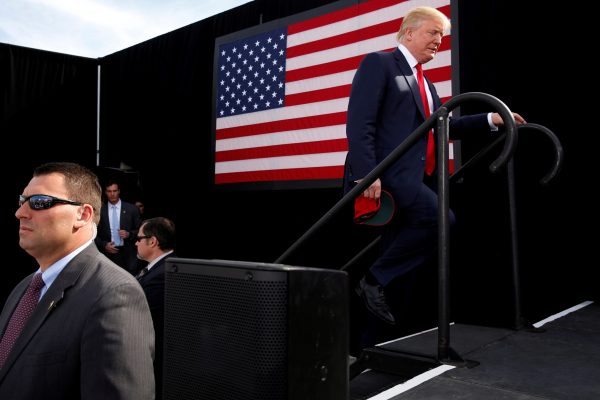Countries are now realising that US leadership is not necessary to promote the values of free trade.
Withdrawing from the TPP, a proposed agreement originally part of the Obama administration’s Rebalance to Asia, was Trump’s first trade action as president and it represented his commitment to the ‘America first’ campaign rhetoric. This executive action was seen as a failure of US commitment to the Asia-Pacific — creating a vacuum in Asia’s power dynamics that a challenger to the United States could then attempt to fill. But in the case of the CPTPP, it was the supporters of the US hegemonic system that filled the vacuum instead. These supporters are now cooperating to uphold the institutions set in place by the United States.
This cooperation is no longer spurred by US leadership but rather by the benefits of a free and open rules-based system. Countries have benefited from the global trading system set in place by the United States and therefore would not want a challenger to change that system. Since the CPTPP welcomes all parties that are willing to improve trading practices to meet the CPTPP standard, signatories are using the CPTPP as a platform not necessarily to contain challengers but rather to better compete with them.
But this kind of multilateral initiative is being tested under the Trump administration. Trump’s trade policy includes a preference for bilateral rather than multilateral trade agreements; a critical view of many existing free trade agreements; and the enforcement of unilateral actions such as Section 201 safeguards, Section 232 tariffs, and the proposed Section 301 tariffs. By questioning existing trade agreements and the efficacy of the World Trade Organization, the United States has made trade partners apprehensive about US commitment to creating and upholding the free and open rules-based trading system.
This undermining of the global trading system will make it difficult for other countries to cooperate with the United States, and it will create a more permissive environment for increased trade barriers going forward. Much of the Trump administration’s concerns are aimed at China. Many commentators have noted that there appear to be problems in Chinese intellectual property transfers, in the lack of reciprocity between Chinese investment abroad and overseas investment into China, and in subsidies provided to state-owned enterprises that generate excess capacity. But the strategies put forth by the Trump administration undercut the importance of working with partners to address such issues.
When Professor Robert Keohane explored the idea of world collaboration without a hegemon in After Hegemony, he did not expect that the hegemon would intentionally undermine the public goods it had created. Other like-minded countries would like to work together with the United States to tackle the rise of China, but it is difficult to do so when they are concerned about US unilateralism that would undermine their efforts.
The day after the CPTPP was signed, President Trump said that he would be open to a multilateral agreement in the region if it were a ‘substantially better deal’. On 12 April 2018, it has been reported that the President instructed United States Trade Representative Robert Lighthizer and Larry Kudlow, the head of the National Economic Council, to study the possibility of re-entering the CPTPP and potentially negotiating for a better deal.
In the past, the 11 signatories have welcomed the possibility of future US reengagement. This is evident in the fact that the parties agreed to suspend about 20 provisions that had been sought primarily by the United States and had been accepted by other countries in return for access to US markets. However, with the US announcement for the potential re-entering of the CPTPP, countries are cautious of immediately triggering another renegotiation process.
The underlying problem is that the Trump administration’s objective in trade policy is unclear, and even promises such as creating more jobs have been counteracted by efforts to reduce the trade deficit. It is important to point out that the Trump administration does not seem to understand that the United States had made very few commitments to change existing US policies in the original TPP. In reality, it was the other 11 countries that were making the changes and adopting US standards and practices. Therefore, renegotiating for a better deal will likely have to wait until the CPTPP signatories finish their ratification process for their hard-won deal.
Lack of US leadership on economic cooperation will not see a struggle for power in creating a new economic system. Instead, it will likely see states cooperating to establish and uphold institutions that are in sync with US values and the global trading system. But if the United States continues to undermine multilateral efforts that support both the United States’ and other states’ interests, cooperation will be much more limited and less capable of taming China’s rise.
John Taishu Pitt (@YJTPitt) is a recent MA graduate from American University where he focused on security and trade relations in East Asia. He currently works as a trade policy specialist at a law firm in Washington D.C.


Is there a reason for “tackling” or “taming” China’s rise? Should we not welcome China’s rise?
I know China and the West do not necessarily agree on everything, but are there not common ground on matters such as climate change, fostering global growth (in an inclusive and sustainable way) and addressing the refugee crisis? Surely the world has more to gain from China9s rise?
Rather than oppose China’s rise, we ought to work with China, including by offering reasoned critique and suggestions for improvement. On the other hand, we ought to be open to critical examination of our own choices, goals and commitments.
There is too much uncritical parochialism among Western countries. We ought to pay more attention to alternative views, especially from emerging countries. Greater pluralism is part of global democracy.